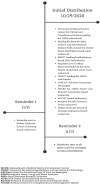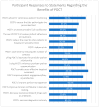Understanding Healthcare Professionals' Perspectives on Point-of-Care Testing
- PMID: 35204622
- PMCID: PMC8870944
- DOI: 10.3390/diagnostics12020533
Understanding Healthcare Professionals' Perspectives on Point-of-Care Testing
Abstract
Point-of-care testing (POCT) is an emerging technology that provides crucial assistance in delivering healthcare. The COVID-19 pandemic led to the accelerated importance of POCT technology due to its in-home accessibility. While POCT use and implementation has increased, little research has been published about how healthcare professionals perceive these technologies. The objective of our study was to examine the current perspectives of healthcare professionals towards POCT. We surveyed healthcare professionals to quantify perceptions of POCT usage, adoption, benefits, and concerns between October 2020 and November 2020. Questions regarding POCT perception were assessed on a 5-point Likert Scale. We received a total of 287 survey responses. Of the respondents, 53.7% were male, 66.6% were white, and 30.7% have been in practice for over 20 years. We found that the most supported benefit was POCTs ability to improve patient management (92%) and that the most supported concern was that POCTs lead to over-testing (30%). This study provides a better understanding of healthcare workers' perspectives on POCT. To improve patient outcomes through the usage of POCT, greater research is needed to assess the needs and concerns of industry and healthcare stakeholders.
Keywords: healthcare provider survey; point-of-care testing; rapid testing.
Conflict of interest statement
The authors declare no conflict of interest. The funders contributed to the design of the survey used in this study; but they did not contribute in the collection, analyses, or interpretation of data; in the writing of the manuscript, or in the decision to publish the results.
Figures





References
-
- Telehealth: Delivering Care Safely during COVID-19. [(accessed on 13 January 2022)]; Available online: https://www.hhs.gov/coronavirus/telehealth/index.html.
-
- Opportunities and Barriers for Telemedicine in the U.S. During the COVID-19 Emergency and Beyond. Kaufman Family Foundation White Paper. [(accessed on 13 January 2022)]. Available online: https://www.kff.org/womens-health-policy/issue-brief/opportunities-and-b...
-
- Ding E., Ensom E., Hafer N., Buchholz B., Picard M.A., Dunlap D., Rogers E., Lawton C., Koren A., Lilly C., et al. Point-of-care technologies in heart, lung, blood and sleep disorders from the Center for Advancing Point-of-Care Technologies. Curr. Opin. Biomed. Eng. 2019;11:58–67. doi: 10.1016/j.cobme.2019.08.011. - DOI - PMC - PubMed
Grants and funding
LinkOut - more resources
Full Text Sources

